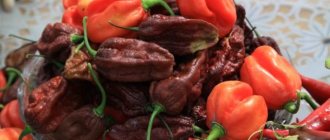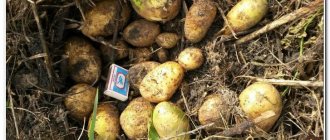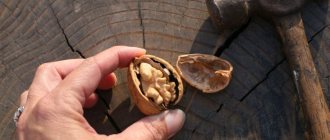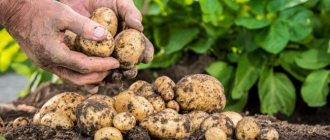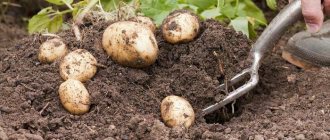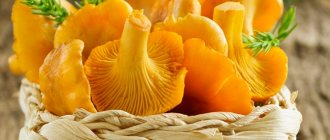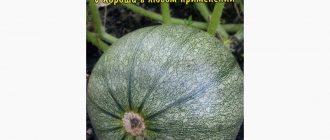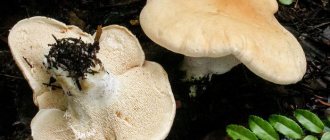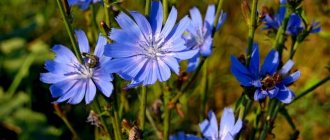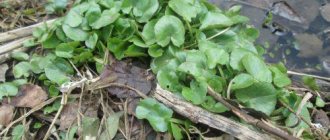general characteristics
Potatoes are a starchy vegetable from the nightshade family [1]. The underground part of the plant, called the tuber, is eaten. Potatoes are the fourth most popular food crop in the world. Its fame is second only to rice, wheat and corn.
Content:
- general characteristics
- Potato varieties
- History of potatoes
- Benefit for health
- Nutritional Components
- Truth and lies about poisons in potatoes
- Medicinal properties
- Possible side effects
- Potatoes in cosmetics
- How to choose and store correctly
Today, several hundred varieties of potatoes are known. They vary in size, shape, color, odor and starch content [2]. As they ripen, young and old potatoes are distinguished.
The skin of most ripe fruits is brown, yellow or reddish and may be smooth or rough. Meanwhile, there are more unusual representatives of the species - with purple skin, and some have the same deep purple flesh.
Today this vegetable with a once sad reputation is one of the most consumed in the world. It is grown commercially in Russia, Poland, India, China, the USA and many other countries.
Description of potatoes
Before we begin to describe potatoes, it is worth recalling their appearance. At first, the kings of Europe used the flowers of the crop as decorations, and had no idea that it was a nutritious and satisfying product. Potatoes began to be grown under Peter the Great. Today it is considered the second bread. Both fresh and frozen potatoes are eaten. There are more than a hundred dishes that are made from it.
Not everyone knows what type of fruit a potato has. And this is not a tuber, as many people think. In addition, potatoes are classified as berries, but according to generally accepted statements, everyone calls them a vegetable.
Advertisements
Potatoes belong to the nightshade family. Solyanum tuberosum (botanical name ) is a perennial crop that is grown in one growing season.
Potatoes are propagated by planting underground shoots. Seeds are used for selective work. In the latter case, the plant has a tap root and many small roots. Potatoes, which are grown from a tuber, have a fibrous root system. Typically, underground vegetative organs lie at a depth of 30-40 cm. In some cases, the root mass goes 80 cm into the ground.
The peel of the underground shoot is colored in different shades depending on the variety: purple, yellow, pink, brown. Usually the flesh is white. Tubers form different shapes:
- oval;
- oblong;
- spherical;
- with bulges.
The weight of individual specimens reaches one kilogram. The description of the crop contains information about eight-kilogram potatoes.
Potato varieties
When choosing potatoes, it is important to consider for what culinary purposes the vegetable should serve [3]. Highly starchy varieties (Elizabeth, Sineglazka, Adretta, Lorch) are considered ideal for purees. Such tubers cook quickly, turning into a tender puree. For soups, it is important to choose potatoes from varieties with a low starch content. As a rule, Red Scarlett, Luck, Leader, Ivan da Marya are suitable for such purposes. They will not boil over and will not spoil the look and taste of the soup. If you are planning to cook fried potatoes, then all your attention should be paid to varieties in which the starch does not break down into sugar, thanks to which the finished potatoes retain their shape. Potatoes from the Nadezhda, Felox, Kolobok, and Leader varieties are ideal for frying.
And now a little secret for those who do not want to remember the names of potato varieties suitable for certain purposes [4].
So, the fewer days a vegetable takes to ripen, the less starch it contains.
There is a classification according to which all varieties of vegetables are divided into 4 classes:
- group A – does not overcook, minimum starch, ideal for salads;
- group B – poorly boiled, suitable for making chips;
- group C – overcooked, suitable for making French fries;
- group D – boils very quickly, good for purees.
Potato connoisseurs also distinguish varieties by skin color:
- white: Bellarosa, Minerva, Tiras; they contain a lot of vitamin C and starch and boil quickly;
- red: Sheri, Red Thumb, Rose Finn Apple, Kamensky; they are rich in antioxidants, do not become overcooked, and are suitable for long-term storage;
- yellow: Symphony, Vineta, Rosalind; vegetables are rich in carotene, have a sweetish taste, and are difficult to cook.
wild potatoes
It is still found in South America. It has lumpy, bitter tubers the size of a walnut. Peruvian Indians found a way to make wild potatoes edible. After some time, potatoes became the main food of the peoples of Latin America. Each Peruvian family grew its own variety of potatoes, passing on knowledge about the selection of an amazing plant by inheritance.
Having arrived in Europe more than 400 years ago, potatoes were long considered a poisonous plant. The vegetable became widespread only in the 18th century, becoming a staple food for many peoples.
Reference. The first description of the strange plant was made by Cieza de Leon, a Spanish historian and conquistador: “...they call Papas, like truffles, after boiling they become as soft inside as boiled chestnuts; it has neither a shell nor a seed, only what truffles have, because it is formed underground, like them.”
Since then, breeders have been constantly working on the taste, increasing the yield and nutritional value of potatoes. Modern potato varieties are very different in yield and size from their wild ancestor, yielding up to 2 kg of tubers from one bush.
Characteristics of wild potatoes
Most varieties of wild potatoes have been cultivated unchanged since the 18th century, propagated by seeds to maintain the purity of the species. Wild potatoes are characterized by low productivity, late ripening, and are grown on private farms. The price of wild potatoes is significantly higher due to the use of manual labor.
The appearance of the ground bush, the color of the stems, leaves and flowers depends on the variety of wild potato. The root system is fibrous, with a small number of stolons and small tuberous tubers.
Varieties of wild vegetable
However, recently wild varieties of potatoes that have not been subjected to selection for two hundred years have become widespread. The unusual taste of wild potato tubers is appreciated by gourmets.
Wild Potatoes Anya
Russian title: Wild White, Anna's Fingers. Potatoes with long, lumpy tubers about the size of your index finger, with pinkish-beige skin and white, waxy flesh. The taste is nutty.
Pink Fir Apple
Fir apple is a wild potato with long, highly lumpy tubers with pink skin and creamy beige flesh. The taste is slightly nutty.
Belle de Fontenay
French potatoes with small, smooth tubers with yellow skin and yellow, dense, waxy pulp.
Vitelotte
Russian name - Wild Black. With oblong, highly tuberous tubers with a dense skin of dark purple, almost black color and purple pulp. It has a nutty taste and a sweetish chestnut smell.
When cooked, it does not change color, it softens greatly, turning into a puree of a rich lilac color. It has strong antioxidant properties, like all colored potato varieties.
Ozette
The oldest variety with elongated, highly tuberous tubers, the skin is brown with small dark brown “freckles” and deep-set eyes. The flesh is dense and creamy white. Taste with notes of roasted chestnuts, slightly sweet.
History of potatoes
Today it is difficult for many to imagine life without potatoes. But in the old days, people fearfully avoided these fruits, although 2000 years ago the ancient Incas grew this plant in the highlands of South America [5]. But even this date is not called the “birthday” of potatoes by historians.
It is believed that this representative of the nightshade family grew on the territory of modern Peru back in the 8th millennium BC. When the Spanish conquistadors conquered Peruvian lands, they first discovered potatoes, which they brought with them to Europe. By the end of the 16th century, families of Basque sailors in northern Spain readily grew it. Just a few years later, this tradition was adopted by the people of Ireland. It took about four decades for potato tubers to captivate the rest of Europe. Eventually, European farmers realized that growing potatoes was much easier than wheat or oats. And during the “gold rush” (late 19th century) in Alaska, this nutritious vegetable was worth almost its weight in precious metal. An equally interesting fact from the “biography” of this plant is that in 1995, NASA and American scientists developed a method for growing potatoes in space [6].
Potato propagation
Fruits
The method of propagating potatoes by seeds is not a very popular method, but it has its advantages. As a rule, potatoes are the vegetable that takes up the most space in the garden, so it is difficult to ensure regular crop rotation. The soil is depleted, the quality of planting material is deteriorating, even replacing tubers with a new type does not help. Solution: growing potatoes from seeds.
Advantages:
- Seeds from the store have been pre-treated and have strong immunity to disease.
- Seeds are much cheaper than seeded tubers.
- The shelf life of seeds is 4-6 years.
There are disadvantages to this method:
- Seedlings require careful care, time and patience.
- The period for growing a full-fledged crop is 2 years. The first harvest is sets, nodules 30-40 grams. A table harvest is obtained only in the second year from sowing seedlings.
On a note ! When propagating potatoes by seeds, the planting material should be renewed after 6-7 years.
Potato seedlings
Tubers
In gardening practice, the main method of planting potatoes is tubers. This type of reproduction is called vegetative. Choose medium-sized fruits up to 100 g, important conditions :
- healthy appearance,
- several eyes.
To get a harvest faster, potatoes are sprouted. This stage is called vernalization. It is carried out 30-40 days before planting in the ground.
During the same period, tubers are treated against diseases and pests:
- "Fitosporin" helps against various fungal diseases,
- "Prestige" from the Colorado potato beetle.
Large tubers are cut into several parts, each with several eyes. It is necessary to cut no earlier than two days before planting in the ground. The cut is sprinkled with activated carbon or ash.
Potatoes love sunny areas; in the shade the bushes stretch out and the tubers turn out small. The best predecessors : legumes, cucumbers, green salad.
Well-groomed potato beds
Benefit for health
Potatoes are extremely popular in most cuisines around the world. But modern people more often consume this vegetable in its not the most healthy form - in the form of chips or fries. Even baked potatoes stuffed with butter, sour cream, processed cheese and bacon lose many of their beneficial properties. In this form, this representative of the nightshade family not only ceases to be useful, it sometimes turns into dangerous food for humans. This is especially true for people with diabetes, cardiac dysfunction, diseased blood vessels, liver or pancreas dysfunction [7].
But despite everything, if you follow the rules for preparing and consuming this vegetable, it is very beneficial for humans [8]. Potatoes contain a variety of phytonutrients that have antioxidant abilities. Among them are health-promoting carotenoids, flavonoids, caffeic acid, and the glycoprotein patatin (important for fighting free radicals).
In addition, studies have shown that potatoes reduce the risk of obesity, diabetes, heart disease, and promote healthy hair and skin.
Benefits for the heart and blood vessels
British scientists have identified a unique substance in potatoes that has antihypertensive properties. Previously, it was believed that the found compound was found only in Chinese barberry.
It is also important to remember that potatoes contain fiber, vitamins C and B6, which are necessary for a strong heart. Fiber helps lower total cholesterol levels, which prevents the risk of heart disease and blood vessel blockage, and potassium reduces the risk of coronary heart disease. As for vitamin B6, it prevents the accumulation of homocysteine in the body, excess of which leads to vascular damage.
Healthy bones and joints
Phosphorus, iron, calcium, zinc and magnesium contained in potatoes contribute to the creation and maintenance of healthy bone tissue. Iron and zinc play a fundamental role in the production of collagen, which is important for joints and cartilage tissue. And phosphorus and calcium are essential components of optimal bone mineralization.
Benefits for the brain and nervous system
Pyridoxine (vitamin B6) contained in this vegetable is extremely beneficial for maintaining neurological health. This component promotes the production of various beneficial substances, including serotonin, dopamine, and norepinephrine. That is, eating potato dishes will help prevent or overcome depression, stress, and even attention deficit disorder caused by hyperactivity.
The large amount of carbohydrates in potatoes has its advantages, since these substances are also important for the adequate functioning of brain cells. Americans have determined that even a slight increase in glucose doses improves the quality of learning. And potassium, the very element that is necessary for heart health, also plays an important role in maintaining the functioning of the brain. This substance, causing vasodilation, improves the supply of oxygen-rich blood to brain cells, without which mental activity is impossible.
Anti-inflammatory
Among the chemical constituents of potatoes, choline should be mentioned. This is the "universal soldier". It is important for maintaining healthy sleep, strengthening memory, improving learning abilities, and strengthening muscles. Choline affects the structure of cell membranes, promotes the transmission of nerve impulses, fat metabolism, and is also important for the prevention and treatment of chronic inflammation.
It has long been believed in scientific circles that potatoes, tomatoes, eggplants and other members of the nightshade family cause exacerbation of arthritis. Meanwhile, not so long ago, the results of new studies refuted this opinion. Volunteers who took part in the study agreed: A 2-week potato diet reduced arthritis symptoms.
This led to the conclusion that nightshades are beneficial for chronic inflammation, particularly in the joints. However, research in this area is still ongoing.
Anti-cancer agent
The raw vegetable contains folic acid, which is an essential component in the process of DNA formation. Avoiding complex scientific terms, we can say that it is folic acid (also known as vitamin B9) that prevents mutations in DNA cells and prevents the formation of cancerous tumors in the body. In addition, scientists have long proven the anti-cancer properties of fiber, of which there is a lot in potatoes. And speaking about the anti-cancer properties of potatoes, one cannot help but recall vitamin C and quercetin. Both substances are contained in the vegetable and both have antioxidant properties, which means they are necessary for the body as protection against free radicals.
Digestion and obesity
And again we will have to remember the beneficial properties of dietary fiber contained in potatoes. They prevent irritation of the mucous membrane of the digestive tract. Fiber-rich foods have a positive effect on bowel function and are also important for preventing and losing excess weight. Fiber, entering the digestive tract, provides a feeling of fullness for a long time and prevents overeating. But in this case we are talking about potatoes cooked without additional high-calorie ingredients and with a limited amount of salt. For example, it can be a baked potato or boiled in its jacket without butter, lard, bacon or other ingredients [9].
When choosing potatoes as an ingredient in a diet for weight loss, it is important to know that the calorie content of boiled and fried products is significantly different.
Potato
Potato
(from German Kartoffel)
perennial tuberous species of the genus Solatium, section Tuberarium, of the Solanaceae family. There are about 200 wild and cultivated species, growing mainly in South and Central America. In culture there are mainly 2 closely related species: K. Andean (S. andigenum), which has long been cultivated in Colombia, Ecuador, Peru, Bolivia and northwestern Argentina, and K. Chilean, or tuberous (S. tuberosum), whose homeland is Middle Chile and surrounding islands, widespread (as an annual crop) in temperate countries. The local population of the mountainous regions of South America also grows S. rybinii, S. goniocalyx, S. ajanhuiri, etc.
The Chilean plant, grown from a tuber, forms a bush 50–80 cm high ( Fig. ), usually of 3–6 stems, green or with anthocyanin (See Anthocyanins). From the axils of the embryonic leaves in the underground part of the stem, underground shoots grow - stolons (15-20 long, in some varieties 40-50 cm), which, thickening at the tops, give rise to new tubers (modified shoots). On the surface of the tuber, in recesses bordered by a leaf scar (edge), there are eyes bearing 3-4 buds. Usually the middle bud germinates, and only when it is damaged do other buds begin to grow. The eyes are arranged in a spiral, and there are especially many of them at the top of the tuber. The shape of the tuber can be round, elongated, oval, etc.; external color and flesh color are white, yellow, pink, red, blue. K.'s root system is fibrous and relatively poorly developed. The leaf of K. is odd-pinnately dissected with lobes, lobes and sometimes lobules, yellow-green to dark green in color, pubescent. An inflorescence of 2-3 (sometimes 4) fork-shaped diverging curls. The flowers are 5-membered, with a spinodolate calyx and incompletely fused white, red-violet, blue-violet corolla lobes. The fruit is a spherical, oval or turnip-shaped berry with small seeds; 1000 pcs. they weigh 0.5-0.6 g.
K. is propagated vegetatively—by tubers (and for breeding purposes—by seeds). Germination of tuber buds in the soil begins at 5-8 °C (the optimal temperature for K germination is 15-20 °C), for photosynthesis, growth of stems, leaves and flowering - 16-22 °C. Tubers form most intensively at night air temperatures of 10-13 °C. High temperatures (at night about 20 °C and above) cause thermal degeneration of plants: plants with sharply reduced productivity develop from seed tubers. Seedlings and young plants are damaged by frosts of -2 °C. The transpiration coefficient of K. averages 400-500. The plant consumes the greatest amount of water during flowering and tuberization. Excess moisture is harmful to K. To form the aerial parts and tubers, K. consumes a lot of nutrients, especially during the period of maximum growth of vegetative mass and the beginning of tuberization. With a harvest of 200-250 centners per hectare, plants extract from the soil 100-175 kg of nitrogen, 40-50 kg of phosphorus and 140-230 kg of potassium (data from D.N. Pryanishnikov). The best soils for soil are chernozems, soddy-podzolic soils, gray forest soils, and drained peat bogs; Mechanical composition: sandy loam, light and medium loam.
K. is the most important culture for its versatile use. Its tubers contain on average 76.3% water and 23.7% dry matter, including 17.5% starch, 0.5% sugars, 1-2% protein, and about 1% mineral salts. The maximum dry matter content in tubers is 36.8%, starch 29.4%, protein 4.6%. K. is also a source of vitamins C, B1, B2, B6, PP, K and carotenoids. More than 100 different dishes can be prepared from K. The food industry produces dried, fried (chips), quick-frozen, potato flakes, potato grits, etc. Potato is of great importance as a raw material for the starch, syrup and alcohol industries. For agricultural feed animals use tubers, tops, stillage and pulp. In the light, glycoalkaloids (solanine and chaconine) accumulate under the skin of the tubers, which can cause poisoning of humans and animals (if their content is higher than 20-50 mg%). During cooking, glycoalkaloids are partially dissolved in water.
The introduction of agriculture into culture (first through the exploitation of wild thickets) began approximately 14 thousand years ago by the Indians of South America. K. was first introduced into Europe (Spain) around 1565. Subsequently, the culture spread to Italy, Belgium, Germany, the Netherlands, France, Great Britain, and others. The appearance of K. in Russia was associated by the Free Economic Society with the name of Peter I, who at the end of the 17th century . sent a bag of tubers from Holland. The beginning of the widespread culture of corn was laid by a decree of the Senate in 1765 and the import of a batch of seed corn from abroad, which was distributed throughout the country. The area under K. began to increase especially quickly in the 40s. 19th century By the end of the 19th century. in Russia they occupied more than 1.5 million hectares.
In 1970, the world area under tubers was about 22.3 million hectares (in Poland 2.7, Germany 0.66, East Germany 0.67, USA 0.54 million hectares), the gross harvest of tubers was about 298 million tons, the average yield is 133 quintals per 1 ha (in the Netherlands 361 quintals per 1 ha, USA 233 quintals, Germany 293 quintals, GDR 192 quintals, Poland 185 quintals). In the USSR in 1971, 7.89 million hectares were occupied under tubers, the gross harvest of tubers was 926 million tons, the average yield was 117 centners per 1 hectare (in Estonia 178 centners, Latvia 160 centners, Belarus 130 centners per 1 hectare). Compared to 1913 (4.2 million hectares), the area of Kazakhstan has almost doubled. The main massifs of Kazakhstan are in the BSSR, in the western and northern parts of the Ukrainian SSR, and in the central and central black earth regions of the RSFSR. On the Kola Peninsula, along the valleys of the Pechora, Ob, and Kolyma rivers, its culture extends beyond the Arctic Circle.
Over the years of K. cultivation, thousands of varieties have arisen. Most modern varieties are obtained by hybridization. In the USSR, potato selection began in 1920 at the Korenevskaya potato breeding station; in 1925 the first Soviet varieties Lorch and Korenevsky were bred here. According to early ripening, K. varieties are divided into early, mid-early, mid-ripening, mid-late and late; by purpose - for canteens, feed, technical and universal. As of 1972, 105 varieties of K were zoned. The most common varieties are Priskulsky early, Lorch and Berlichingen, which are cultivated almost everywhere. Varieties Petrovsky, Stolovy 19, Olev, Detskoselsky, Kameraz, Voltman, Yubel, Polessky, Parnassia, Loshitsky, Sedov, Borodyansky and others are also grown.
With good soil cultivation and proper use of fertilizers, crops produce high yields even when grown for a long time in the same place. In field and forage crop rotations of the non-chernozem zone, it is placed along the rotation of the grass layer, after winter crops and flax, on sandy soils - after lupine, in the central chernozem regions, in Ukraine, the North Caucasus, in the Volga region and Central Asia - after winter crops, annual grasses and corn, in Kazakhstan and Eastern Siberia - after grain and legume-cereal mixtures, in the Urals and the Far East - after grain and leguminous mixtures. In suburban areas, K. is usually grown in vegetable crop rotations. Early K. is a fallow crop. K. develops well on loose, weed-free, deeply cultivated soils. In autumn, the soil under soil is plowed to a depth of 27–30 cm, and soils with a smaller topsoil are plowed to its entire depth (with additional subsurface loosening). In the spring, in the non-chernozem zone, fields are harrowed and plowed (on floating soils and when organic fertilizers are applied in the spring) to a depth of 17-20 cm or deeply cultivated to a depth of 12-15 cm. In the forest-steppe and steppe zones, the soil is loosened twice with cultivators. Among organic fertilizers, manure and composts (20–40 t/ha) are applied to soil in autumn and spring; green fertilizer is used on sandy soils. Doses of mineral fertilizers designed to produce a tuber yield of 150-200 centners per hectare: 20-60 kg/ha of nitrogen, phosphorus and potassium when applying manure and 20-90 kg/ha without applying it; for pre-sowing application (in furrows) - 10-20 kg/ha of phosphorus and 15-20 kg/ha of nitrogen; in fertilizing - 20-30 kg/ha of nitrogen and potassium.
For planting tubers of medium size—50–80 g—are selected. Seed tubers are pre-germinated, which speeds up the emergence of seedlings by 7–10 days. K. is planted when the soil at a depth of 8-10 cm warms up to 6-8 °C. First of all, early varieties are planted in fallow fields. In Central Asia, pre-winter or winter (January - February) plantings of early varieties are used. K. is planted with potato planters; row spacing 60, 70 or 90 cm; between plants in a row -25, 30, 35 or 23 cm. The norm of seed tubers is 2.5-3.5 t/ha. Planting depth is 6-12 cm. Before germination, the crops are harrowed twice, and after germination they are loosened several times. In the non-chernozem zone and northern. In areas of the chernozem zone, soil is hilled (with moist soil). Herbicides are used to kill weeds: 2,4-D (sodium and amine salts, esters), nitrophen. Potatoes are harvested with a potato harvester (See Potato harvester) or a potato digger (See Potato digger); for long-term storage - after the skin has hardened, in the south - when the tops die, early K. - after reaching economic suitability. 2-6 days before harvesting, the tops are mowed using a tops harvesting machine (See tops harvesting machine). After drying and sorting, the tubers are stored in the Potato Storage Facility.
K. is affected by a variety of diseases: fungal diseases - late blight, cancer, macrosporiosis, scab; bacterial - black leg, ring rot; viral - mosaics, leaf curling; nematodes - potato and stem nematodes. K.'s pests are mole crickets, wireworms and false wireworms, sometimes the meadow moth, gamma armyworm, and slugs. The Colorado potato beetle and, in the Far East, the potato ladybug are also dangerous.
Lit.: Lekhnovich V.S., On the history of potato culture in Russia, in the book: Materials on the history of agriculture in the USSR, collection. 2, M. - L., 1956; Bukasov S. M., Kameraz A. Ya., Fundamentals of potato breeding, M. - L., 1959; Zhukova G.S., Pisarev B.A., Kuznetsov A.I., Potato agricultural technology in the main zones of the RSFSR, M., 1964; Kameraz A. Ya., Early potatoes, L., 1967; New in potato growing, ed. N. A. Dorozhkina, Minsk, 1967; Vereshchagin N.I., Malko A.I., Pshechenkov K.A., A short reference book for a potato grower, M., 1968; Potatoes, ed. N. S. Batsanova, M., 1970.
V. S. Lekhnovich, K. Z. Budin, A. Ya. Kameraz.
Potato: 1 - flowering plant with old (dark) and young tubers; 2 - branch with flowers; 3 - flower.
Source: Great Soviet Encyclopedia on Gufo.me
Meanings in other dictionaries
- potato - Borrowing from German, where Kartoffel ("potato") had the former form Tartuffel, going back through the Italian tartufolo ("truffle") to the Latin terratuber, which literally means "earth cone" from terra - "earth" and tuber - "cone" . Krylov's etymological dictionary
- Potatoes - From a culinary point of view, a product that allows for universal use and has many cooking methods. Boiled in water, steamed, fried in all types of oil and fats... Culinary Dictionary
- potatoes - spelling potatoes, -i Lopatin's Spelling Dictionary
- potato - Potato/. Morphemic-spelling dictionary
- potato - noun, number of synonyms... Russian synonym dictionary
- Potato - (Solanum tuberosum) is a perennial herb from the nightshade family (Solanaceae) and the extensive genus Nightshade (see). The leaves are imparipinnate, moreover, their leaflets are of unequal size: some are large and form from 3 to 5 pairs, others are small, sitting between the large ones. Encyclopedic Dictionary of Brockhaus and Efron
- potatoes - Borrowed. in the second half of the 18th century. from it. lang., where Kartoffel < Tartuffel - from Italian. tartufolo "potato" < "truffle", dating back to Lat. terratuber “earth cone” (terra “earth”, tuber “tuber, cone”). See Shansky's Etymological Dictionary
- Potato - (English potato), according to botany, this plant was probably domesticated in the southern Peruvian Andes and northern Bolivia (the area between Cusco and Lake Titicaca). Modern archaeological data make it possible to include in the field of cultivation... Archaeological Dictionary
- Potatoes - See Vegetables. Medical encyclopedia
- potatoes - potatoes m., dial. potatoes, arkhang. (Dev.), potato, potato, potato, potato, cartish (Transform.), potato, Tobolsk. (Zhst., 1899, issue 4, p. 495), Gartokhlya, Voronezh. (Dal), Ukrainian potatoes The first is from it. Etymological Dictionary of Max Vasmer
- POTATOES - POTATOES are perennial tuberous species (about 150) of the genus Solanaceae of the Solanaceae family. Andean potatoes are grown for food, feed and technical purposes (in the South. Big Encyclopedic Dictionary
- potatoes are perennial tuberous plants of the nightshade genus. The fruit is a berry with small seeds. OK. 150 species, prem. in South and Center. America. In culture there are 2 types: food, fodder and technical. plants. K. Andean (Solatium andigenum) has long been cultivated in the South. Biological encyclopedic dictionary
- potatoes - Perennial tuberous species (approx. 150) of plants of the family. Solanaceae In countries with temperate climates, incl. In Russia, European or Chilean (or tuberous) potatoes are grown as an annual crop. Biology. Modern encyclopedia
- potato - -i (s), m. 1. Garden plant of the family. nightshade, vegetable Here and there on the late potato bushes small lavender flowers with yellow stamens were still visible. Nikolaev, Harvest. 2. collected The underground tubers of this plant are eaten. Small academic dictionary
- potatoes - POTATOES -i (s); m. [German] Kartoffel] Garden plant of the family. nightshade with starch-rich tubers. // collected The underground tubers of this plant are eaten. Fried k. Boil k. ◁ Potato, -aya, -oe. K-th field. K-th tubers. Some puree. K. soup. K flour (potato starch). Kuznetsov's Explanatory Dictionary
- potatoes - German - Kartoffel. Italian – tartufolo (truffle). In the Russian language, the word became widespread in the second third of the 18th century. It was borrowed from the German language, which came from Italian. Etymological Dictionary of Semenov
- potato - POTATO (German: Kartoffel), perennial tuberous species of the genus Nightshade family. nightshade, starch and vegetable crops. OK. 150 wild and cultivated species growing predominantly. in South and Center. America. In culture (as annual areas) mainly. Agricultural Dictionary
- potatoes - Potatoes, potatoes, potatoes, potatoes, potatoes, potatoes, potatoes, potatoes, potatoes, potatoes, potatoes, potatoes Zaliznyak's Grammar Dictionary
- potatoes - POTATOES m. potatoes, potatoes, potatoes (gartoplya) w. zap. south kartos, kartish, corfettes m. pl. Vyat. kartovka perm. potatoes, potato tul. Moscow earthen or devil's apple, in Sib. just an apple (there are no other apples there); Barabolya, Baraboshka Novoross. Dahl's Explanatory Dictionary
- potatoes - POTATOES, I (u), m. Tuber crop of the family. nightshade with starch-rich tubers, as well as (collected) the tubers themselves. | adj. potato, oh, oh. Potato flour (starch from potatoes). Ozhegov's Explanatory Dictionary
- potatoes - POTATOES I, m. cartoufle, tartoufle > German. Kartoffel. 1. A plant with tubers growing in the ground and eaten. K. - originally from South America, imported to Europe in the 16th century, known in Russia from the end of the 17th century, and spread by government measures in the 19th. Dictionary of Gallicisms of the Russian language
- potato - Potatoes, plural. no, m. [German] Kartoffel]. 1. A plant with tubers growing in the ground and eaten (bot.). Potatoes are originally from South America, imported to Western Europe in the 16th century, known in Russia since the end of the 17th century, and spread by government measures in the 19th. Large dictionary of foreign words
- potatoes - KART'OFEL, potatoes, plural. no, husband (·German: Kartoffel). 1. A plant with tubers growing in the ground and eaten (bot.). Potatoes are native to South America, in the West. Introduced to Europe in the 16th century. Ushakov's Explanatory Dictionary
- potato - potato m. 1. Garden plant of the nightshade family. 2. Tubers of such a plant used for food. Explanatory Dictionary by Efremova
- Blog
- Jerzy Lec
- Contacts
- Terms of use
© 2005—2021 Gufo.me
Nutritional Components
This starchy vegetable is one of the best sources of soluble and insoluble fiber, as well as B vitamins. It is extremely rich in potassium, but in addition to this nutrient, it contains a lot of iron, manganese, magnesium, phosphorus and copper. Most of us are accustomed to the fact that the best “suppliers” of ascorbic acid are citrus fruits. Meanwhile, 100 grams of potatoes contain almost half of the daily requirement of vitamin C (especially large reserves of ascorbic acid are present in young potatoes).
Interestingly, the proteins contained in the vegetable contain almost all the amino acids necessary for humans.
Nutritional value per 100 g [10]
| Calorie content | 70 kcal |
| Carbohydrates | 15.9 g |
| Squirrels | 1.9 g |
| Fats | 0.1 g |
| Cellulose | 2.5 g |
| Vitamin B1 | 0.08 mg |
| Vitamin B2 | 0.038 mg |
| Vitamin B3 | 1.15 mg |
| Vitamin B5 | 0.28 mg |
| Vitamin B6 | 0.24 mg |
| Vitamin B9 | 18 mcg |
| Vitamin A | 7 IU |
| Vitamin C | 11.4 mg |
| Vitamin K | 2.9 mcg |
| Potassium | 455 mg |
| Sodium | 6 mg |
| Calcium | 10 mg |
| Iron | 0.73 mg |
| Magnesium | 22 mg |
| Manganese | 0.41 mg |
| Phosphorus | 61 mg |
| Zinc | 0.33 mg |
The benefits of potatoes
The beneficial properties of potatoes are associated with its nutritional value and the presence of a vitamin and mineral complex. And although the benefits of vitamins and minerals are not so significant due to their low content, they partially meet the body’s needs. This product is in demand for
- Gaining weight or expending a lot of energy. The carbohydrate starch breaks down in the body into glucose and fructose, maintaining the balance of energy and plastic metabolism in the body. Removes excess salts and fluid from the body.
- Works of the digestive tract. Viscous puree or fiber in the form of thin fibers improves peristalsis and digestion, helping to timely empty the intestines of unnecessary waste products.
- Skin that has a pale or dull appearance. Potato pulp is applied as a mask to the face. It “works” with minerals, exfoliating the skin, removing redness and dark spots. Thanks to the antioxidants in the composition, it inhibits the aging of the epidermis.
- Partial relief of vitamin C deficiency, which saves from scurvy and improves the body's immunity.
- Joints and muscles when inflammation occurs. Potatoes contain calcium and magnesium, which help in treating rheumatism. Thanks to antioxidants, it is capable of regenerating damaged tissues.
- Reducing blood pressure, which increases due to various health problems: diabetes, stress, nutritional imbalance.
- The work of the brain, which requires significant supplies of glucose. 70% of incoming carbohydrates are spent on brain tissue.
- Improves hematopoiesis and increases the level of hemoglobin in the blood, as the composition contains iron.
Truth and lies about poisons in potatoes
Sometimes people wonder whether potato “eyes” are poisonous and whether they can be eaten. Health nutrition experts say that the “eyes” become poisonous only after germination. You should also not eat the stems, leaves and fruits of the potato plant as they actually contain poisonous components such as arsenic and solanine. For the same reason, greened tubers are not eaten [11].
The best soil for potatoes
— chernozems, sod-podzolic, gray-forest, drained peatlands;
— mechanical composition: sandy loam, light and medium loam.
- The soil for potatoes should be loose: compacted soil will form small and deformed tubers.
- The best fertilizers are potassium salts, then bone meal, lime, and rotted manure. Excess nitrogen fertilizers in the soil is undesirable, as this promotes the growth of tops to the detriment of the formation of tubers.
Medicinal properties
As already mentioned, the Incas were the first to learn to grow potatoes. It was they who noticed the healing properties of this vegetable. For them, the nightshade representative served not only as a nutritious dinner. Here are some interesting ways to use potato tubers as medicine:
- The Incas applied raw slices of the vegetable to fracture sites to speed up the healing of the injury.
- Potatoes were used as a remedy to prevent rheumatism.
- The vegetable was used as a medicine for stomach disorders.
- In folk medicine, potato juice was used to get rid of age spots.
- Frostbite and sunburn were treated with raw vegetable pulp or its juice.
- Ancient healers tied a baked potato wrapped in cloth to the throat to treat sore throat.
- In the old days, people got rid of any kind of pain by rubbing the sore spot with a decoction in which the vegetable was cooked.
Potato reproduction
How does the update take place, i.e. improvement of the variety?
In order to improve the health of potato seed material, the meristem method is used:
First stage: obtaining healthy test tube plants (first year)
From the array of plants, one plant is isolated that is healthy by external signs. Next, 1 meristematic cell is isolated from it (the one that constantly and intensively divides and the whole plant grows from it), placed on a nutrient medium and a small potato plant is grown in a test tube, on the roots of which MICRO TUBERS are formed. Since there is very little of this material, such a test tube with a meristem plant is very expensive.
Second stage : production of mini-tubers, planting test tube plants in a hydroponic greenhouse.
Hydroponic installations, Mini tubers
in the frame - individual plants in a hydroponic greenhouse
“micro tubers” are planted in a greenhouse, and when harvested, “MINI TUBERS” are obtained.
Third stage: propagation of seed material in the field:
- “mini tubers” are planted in the field and the first field reproduction of potatoes is obtained (second year);
- further, in the (third year) the harvest obtained in the field is called “super, super elite.” This is also not that much.
- then similarly, after a year, they get “super elite” (fourth year)
- then “elite”, after that “1st reproduction” and “2nd reproduction”. At each stage of material reproduction, tests are constantly carried out for the presence of a viral infection (ELISA test, PCR test). The viral material is discarded. Also at each stage, the material is accepted in accordance with GOST 7001-91
Respectively:
- “test tube plants”, “micro tubers” and “mini tubers” are original material, rarely sold and for a lot of money.
- “super super elite”, “super elite”, “elite” - elite material, from which I get seeds. It is approximately 5 times more expensive than commercial potatoes.
- The first reproduction and the second reproduction are reproduction material.
Thus, the lower the reproduction from test tube plants to the second reproduction, the higher the tolerances for varietal purity, material quality, mechanical damage and, of course, diseases according to GOST 7001-91.!!!!!
We are on social networks: Feel free to join groups, write comments, read and discuss daily articles on social networks!
Possible side effects
Potatoes in themselves are not dangerous to humans. However, there are some nuances that determine the quality of the product and its beneficial properties. If a vegetable is exposed to heavy pesticides during cultivation, it can become hazardous to health. Nutritionists also call French fries harmful, as they often contain trans fats and carcinogenic substances.
Do not forget that starchy potatoes contain quite a lot of carbohydrates that can be quickly absorbed, that is, they belong to a food with a high glycemic index. A sharp increase in blood sugar concentration is an extremely undesirable reaction for diabetics. For this reason, people with “sugar disease” are advised to avoid large portions of potatoes.
Potato degeneration
The main reason for the degeneration of potatoes is the infection of plants by viruses. Infection of healthy plants from infected ones occurs due to mechanical damage during planting, caring for plants, and harvesting; transmitted by insects during the growing season. Potatoes are affected by more than 20 viruses. The presence of viruses in tubers causes their woodiness and reduced yield. Externally, on plants, the infection manifests itself in the form of mottling, interveinal mosaic, curling and curling of leaves, a bouquet of a similar bush, yellow dwarfism, and the like.
If you use the same potato seeds for years, then there is a gradual progressive accumulation of viral infection in the seeds (tubers)!
That is, when you bought seeds, roughly speaking, out of 100 tubers you have one with a virus, i.e. a diseased tuber will produce offspring, which you will also sow next year, but the percentage of diseased tubers will be greater. And so on until 100% of the seed material is infected with a viral infection. Accordingly, the reduction in yield over the years will only increase.
How can you update the variety? It is necessary to purchase new seed (certified) material.
Potatoes in cosmetics
The healthy appearance and youth of the skin directly depend on the concentration of collagen in the body. Vitamin C, which is part of potatoes, not only works as an antioxidant, protecting the skin from the harmful effects of dust, smoke and UV radiation, but also activates collagen production. Thus, we can say that regular potatoes smooth out wrinkles and improve the overall condition of the skin.
Potatoes will also help:
- removes dark circles under the eyes (apply raw slices for 20 minutes or apply potato juice with a cotton swab);
- smoothes wrinkles;
- removes age spots (apply a mask of chopped raw vegetables to your face);
- heals sunburn (apply vegetable juice to damaged areas or apply slices of raw potatoes);
- nourishes dry skin (make masks from cottage cheese and raw potatoes);
- relieves itching after insect bites (apply a slice to the bite site);
- reduces swelling of the eyelids.
Potatoes are not only an excellent cosmetic product for the skin, they are also good for hair:
- strengthens hair (make a mask from potato pulp, eggs and lemon juice);
- prevents graying (rinse hair with water in which potatoes were boiled);
- stops hair loss (make a mask of honey, aloe juice and potatoes).
History of the origin of potatoes
The homeland of potatoes, its origin is associated with Latin America. Residents of Peru and Bolivia not only enjoyed eating healthy tubers, but also performed rituals with them, deifying the plant sent to them from heaven.
There are many versions of who brought the potato fruit to the European continent. The most reliable of them is that this is the work of a monk-traveler named Neronim Kordan. It was he who lowered a basket filled with strange tubers onto Spanish soil. This fateful event for culinary experts took place in the 16th century.
However, Europeans were hostile to the overseas product, considering it unsuitable for food. But potatoes found a unique use: gardeners decorated their flower beds with the plant, and ladies from high society decorated their hairstyles. And only in 1755, when famine broke out in Europe, did they find out that the “earth apple” was quite suitable for food. There was no talk about benefits for the body in those days.
The history of potatoes in Russia was also not simple. In the 17th century, Peter 1 visited Holland and from there sent a parcel with wonderful earthen fruits to Count Sheremetyev with a note “for brood.” They began to eat potatoes at the royal court as a kind of delicacy, sprinkling them with sugar. No one thought about its benefits; the courtiers simply followed the king’s orders.
The peasants continued to grow turnips, not recognizing potatoes. They tried to eat green fruit, which led to mass poisoning. There are known uprisings called “potato riots.” And only under Nicholas 1 did mass cultivation of this tuber crop begin. A decree was issued that obliged peasants to grow potatoes and eat them.
The author of many works on agriculture, V.A. Levshin, recognized the benefits and nutritional value of potatoes. But he was mistaken when he described that “tubers dug out of the ground are unhealthy, they need to be well weathered and wait until they wilt.”
Potato harvesting
First of all, early potatoes are harvested, then mid-season and late ones. A sign of potato maturity is always the tops; if they are dry, you can safely dig them up.
If the area for planting potatoes is medium in size, then harvesting potatoes will not be difficult. Manually harvesting potatoes is an unpleasant task, but it is effective. Before harvesting, the area is cleared of tops and weeds for ease of harvesting potatoes. They dig up the potatoes with a shovel, sort them and collect them in bags.
Another method of harvesting involves the use of small-sized agricultural assistants: tractors and potato diggers for them. Productivity increases, the cost of physical labor decreases. But there are “pitfalls” in the mechanical method; before harvesting, the area must be completely cleared, the digging machine must be adjusted to the maximum. One mistake in the markings or an error in the pre-harvest settings of the unit and the crop will be damaged.
On an industrial scale the situation is different. The cleaning area is huge and cannot be done without the help of mechanized equipment. Potato harvesters do an excellent job, provided that pre-harvest agrotechnical measures are observed.
The most widespread is the combined method of harvesting potatoes. The idea is to first mow the tops and remove the weeds, then the combine digs up the potatoes, placing them in the space between adjacent rows, and collects them after drying.
Choosing a place and soil for planting potatoes
The right place and suitable soil for planting and growing potatoes are very important. When choosing, you should be guided by the following rules:
- The place should be open, well lit by the sun during the day.
- The site must be level, without slope.
- It is recommended to avoid lowlands in which moisture accumulates, as well as excessively waterlogged areas and places with high groundwater levels.
- The soil should be loose, fertile, nutritious.
- The culture prefers light loamy or sandy loam soils.
- Heavy, clayey soils are not suitable, since this crop requires a lot of oxygen for normal growth and development, and such soils have poor air permeability.
Increasing potato yields
Compliance with the following measures to increase potato yields will help increase not only the quantity, but also the quality of potato tubers.
- A correctly selected variety, taking into account climatic standards and high-quality planting material is the key to success.
- Maintaining crop rotation is the second step to increasing potato yield.
- Highly nutritious fertile soil is one of the foundations for obtaining the desired result.
- Plant sparingly - potato tubers need space to grow.
- Avoid small tubers for planting. The seed must be at least medium in size.
- Cut off flowers - these are the main pests of tubers. They take about 20% of all nutrients.
- Fertilizing the crop during the growing season triples the yield.
Potato care
To grow potatoes in open soil, you need to take good and proper care of them, and you should start doing this before the shoots appear. The area needs to be loosened and weeded in a timely manner, in this case the root crops in the ground will have access to air. Before seedlings emerge, you can loosen the soil surface using a rake. After the potatoes have sprung, you need to regularly loosen the surface of the soil between the rows, and this should be done every time it rains or the plantings are watered. Do not allow a crust to form on the soil.
Caring for potatoes is relatively simple: they need to be watered, loosened, weeds removed, hilled, fed and treated against harmful insects and diseases in a timely manner.
How to water
Before buds begin to form on the bushes, this crop does not need to be watered. However, as soon as the budding period begins, you need to ensure that the soil on the site is moist all the time. Watering should be done only after the soil on the site has dried to 60–80 mm. Watering should be done in the evening, with 2 to 3 liters of water taken per bush. When the area is watered, its surface should be loosened.
Hilling up potatoes
Over time, the grown bushes will need hilling; to do this, earth should be raked under the base of the potatoes, grabbing it from the inter-row spaces. As a result, the area will look ridged, even if a smooth planting method was used. Hilled bushes will not fall apart, and their stolons will grow more actively, and they contribute to the formation of the crop. You need to hill up potato bushes at least 2 times during the season. The first hilling is carried out after the height of the bushes is 14–16 centimeters, and the plants should be hilled again 15–20 days later, before they bloom. It is easiest to hill up the bushes when they are watered or it has rained.
Fertilizer
To feed this crop, organic matter is used, namely: a solution of chicken manure or slurry. If necessary, plants are fed with a solution of mineral fertilizer. But before you start fertilizing, you should think about the composition of the soil and how much fertilizer was added to it before planting the potatoes. Try not to disturb the nutritional balance of the soil; remember that applying a very large amount of fertilizer will have an extremely negative impact on the quality of the crop.
Benefits of plants
The important benefits of nightshades - potatoes, tomatoes, peppers and others - are described in some detail above. On the one hand, it is a hearty and tasty meal that can be prepared in a variety of ways. On the other hand, many fruits contain essential elements that almost completely satisfy human needs for vitamins and microelements. And the use in medicine – traditional and folk – has already been discussed enough above.
However, like everything in our world, nightshades have a downside. It turns out that they can pose a serious danger that is very important to be aware of.
Harvesting and storage
Potato harvesting begins before the onset of stable frosts, usually in early September. It is also worth considering that the weather should be warm and dry. 6-7 days before harvesting, the tops are mowed and removed.
The dug up tubers are dried in the fresh air, sorted and stored in a scattered state for 2-3 weeks in a barn or under a canopy, but without access to daylight, otherwise the tubers will begin to turn green, and this is highly undesirable. After drying, the tubers are sorted again and placed in bags or boxes and stored at a temperature of 1-5 C in the basement or cellar.
